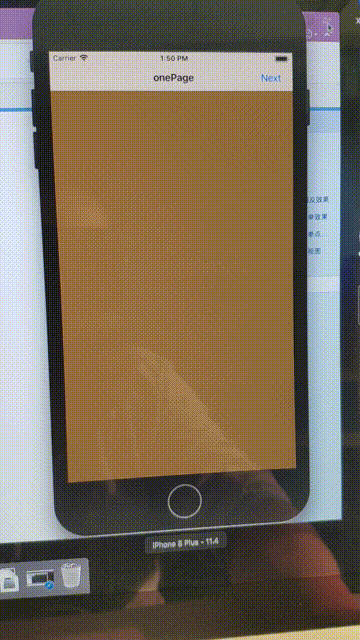IOS初學-導航檢視控制器的使用
阿新 • • 發佈:2018-11-13
檢視控制器的跳轉方式。入棧和出棧
首先需要建立兩個檢視控制器

在FirstSubViewController中修改程式碼
//導航檢視控制器的使用 func test1() { self.title="onePage" self.view.backgroundColor=UIColor.brown; //設定右上角導航按鈕的樣式和功能。當點選按鈕時 頁面跳轉至第二個檢視控制器 self.navigationItem.rightBarButtonItem=UIBarButtonItem(title: "Next", style: UIBarButtonItemStyle.plain, target: self, action: #selector(FirstSubViewController.nextPage)); } @objc func nextPage(){ //初始化第二個檢視控制器 let twoPage=SecondSubViewController(); //將第二個檢視壓入導航控制器 實現頁面跳轉 self.navigationController?.pushViewController(twoPage, animated: true); }
在SecondSubViewController中修改程式碼
self.view.backgroundColor=UIColor.purple;
self.title="222222"在FirstSubViewController中編輯程式碼
func test1() { self.title="onePage" self.view.backgroundColor=UIColor.brown; //設定右上角導航按鈕的樣式和功能。當點選按鈕時 頁面跳轉至第二個檢視控制器 self.navigationItem.rightBarButtonItem=UIBarButtonItem(title: "Next", style: UIBarButtonItemStyle.plain, target: self, action: #selector(FirstSubViewController.nextPage)); } @objc func nextPage(){ //初始化第二個檢視控制器 let twoPage=SecondSubViewController(); //將第二個檢視壓入導航控制器 實現頁面跳轉 self.navigationController?.pushViewController(twoPage, animated: true); }
最後設定程式的入口
func application(_ application: UIApplication, didFinishLaunchingWithOptions launchOptions: [UIApplicationLaunchOptionsKey: Any]?) -> Bool { let navigationController=UINavigationController(rootViewController: FirstSubViewController()); self.window?.rootViewController=navigationController; return true }

在上一版程式碼的基礎上 增加了隱藏工具欄和導航的程式碼
在FirstSubViewController中重寫方法
//檢視控制器 生命週期中 檢視即將顯示的方法
override func viewWillAppear(_ animated: Bool) {
super.viewWillAppear(animated);
//顯示工具欄
self.navigationController?.setToolbarHidden(false, animated: true);
}SecondSubViewController中新增隱藏的button的方法
let button1=UIButton(frame: CGRect(x: 40, y: 200, width: 240, height: 30));
button1.setTitle("hide navigation bar", for: UIControlState());
button1.backgroundColor=UIColor.orange;
button1.addTarget(self, action: #selector(SecondSubViewController.hideNavigationBar), for: UIControlEvents.touchUpInside);
self.view.addSubview(button1);
let button2=UIButton(frame: CGRect(x: 40, y: 260, width: 240, height: 30));
button2.setTitle("hide tool bar", for: UIControlState());
button2.backgroundColor=UIColor.orange;
button2.addTarget(self, action: #selector(SecondSubViewController.hideToolBar), for: UIControlEvents.touchUpInside);
self.view.addSubview(button2);//隱藏頂部導航欄
@objc func hideNavigationBar(){
self.navigationController?.setNavigationBarHidden(true, animated: true);
}
//隱藏底部工具欄
@objc func hideToolBar(){
self.navigationController?.setToolbarHidden(true, animated: true);
}
override func didReceiveMemoryWarning() {
super.didReceiveMemoryWarning()
// Dispose of any resources that can be recreated.
}
修改導航欄中的樣式

直接在上一版中的程式碼進行修改。在viewWillAppear方法中
//檢視控制器 生命週期中 檢視即將顯示的方法
override func viewWillAppear(_ animated: Bool) {
super.viewWillAppear(animated);
//顯示工具欄
self.navigationController?.setToolbarHidden(false, animated: true);
self.navigationItem.prompt="這裡是標題文字"
//設定導航欄的背景不透明
self.navigationController?.navigationBar.isTranslucent=false;
//設定導航欄的樣式為黑色
self.navigationController?.navigationBar.barStyle=UIBarStyle.black;
//設定導航按鈕的前景色
self.navigationController?.navigationBar.tintColor=UIColor.orange;
}
